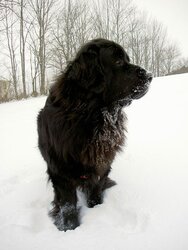Hello.
I am sure I am asking a question that has been posted before, but if you can bare with me, I hope to learn from your experience. I want to heat with a wood stove (naturally). In particular I am looking at two Pacific Energy units, Super 27 and Summit. The house is a 1.5 story 1800 sqft modular cape built in 1995. The insulation is standard for the construction. The stove will be located in the center of the house and the house is partitioned. I would like to primarily heat with wood, but I will have an oil burner. The specs for the Super 27 would say it is good for this building. Because of the winters here in Central Maine, I am wondering if the Summit would be a better fit.
How bad is having a stove that is too big?
And here is where things get fuzzy for me (not really questions but things that are bugging me in order to get to an answer):
Early in the season, most stoves are going to have to be dampened simply because heat loss from the building is going to be lower. They are effectively too big for the space, but it can't be a serious problem.
Burns do not give even output--it takes time to warm up and will die down over time so heating is not even over time.
I plan to cut my own wood from my own property and so will be using hardwoods and softwoods and so I imagine a large stove will work better with the lower energy of softwoods.
Why not use less wood so not to overheat a space? Wouldn't five pounds of wood give off equal energy regardless of the difference between a medium and large firebox (in particular, the Super 27 and Summit)?
I understand the large firebox can give longer burn times because it can hold more fuel. Wouldn't restocking and restarting a smaller stove be less efficient?
I have never heated with wood before. Your thoughts are appreciated.
I am sure I am asking a question that has been posted before, but if you can bare with me, I hope to learn from your experience. I want to heat with a wood stove (naturally). In particular I am looking at two Pacific Energy units, Super 27 and Summit. The house is a 1.5 story 1800 sqft modular cape built in 1995. The insulation is standard for the construction. The stove will be located in the center of the house and the house is partitioned. I would like to primarily heat with wood, but I will have an oil burner. The specs for the Super 27 would say it is good for this building. Because of the winters here in Central Maine, I am wondering if the Summit would be a better fit.
How bad is having a stove that is too big?
And here is where things get fuzzy for me (not really questions but things that are bugging me in order to get to an answer):
Early in the season, most stoves are going to have to be dampened simply because heat loss from the building is going to be lower. They are effectively too big for the space, but it can't be a serious problem.
Burns do not give even output--it takes time to warm up and will die down over time so heating is not even over time.
I plan to cut my own wood from my own property and so will be using hardwoods and softwoods and so I imagine a large stove will work better with the lower energy of softwoods.
Why not use less wood so not to overheat a space? Wouldn't five pounds of wood give off equal energy regardless of the difference between a medium and large firebox (in particular, the Super 27 and Summit)?
I understand the large firebox can give longer burn times because it can hold more fuel. Wouldn't restocking and restarting a smaller stove be less efficient?
I have never heated with wood before. Your thoughts are appreciated.





 I don't like being that warm in the summer, no way I'm interested in that during the winter! I have my house at 70* right now due to newborn in the house and it's driving me nuts!
I don't like being that warm in the summer, no way I'm interested in that during the winter! I have my house at 70* right now due to newborn in the house and it's driving me nuts!